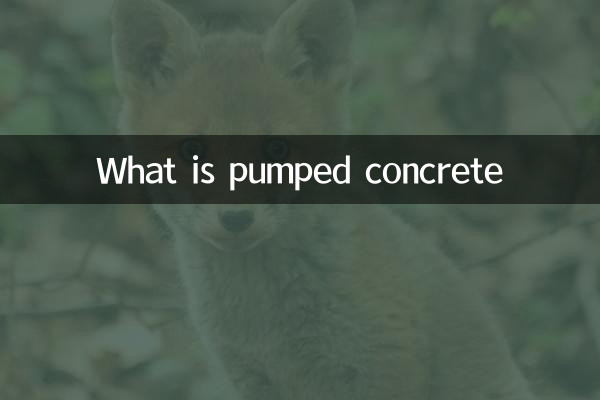What is pumped concrete
Pumping concrete is a modern construction technology that transports concrete to the construction site through concrete pumps and conveying pipes. It is widely used in high-rise buildings, bridges, tunnels and other projects, and can effectively improve construction efficiency and reduce labor intensity. The following is a detailed introduction to pumped concrete.
1. Definition of pumped concrete

Pumped concrete refers to the construction method in which premixed concrete is transported to a designated location through the pipe through the pressure of the concrete pump. This technology is especially suitable for large-volume concrete pouring, high-rise buildings or construction scenarios where manual transportation is difficult.
2. Advantages of pumping concrete
| advantage | illustrate |
|---|---|
| High construction efficiency | The pumping speed is much faster than traditional manual transportation, greatly shortening the construction period |
| Save labor costs | Reduce the number of transport workers and reduce labor costs |
| Strong adaptability | Can be transported to high altitude, long distances or complex terrain areas |
| Stable quality | Reduce concrete separation phenomenon and ensure pouring quality |
3. Technical points of pumping concrete
| Technical Highlights | Specific requirements |
|---|---|
| Slump control | Generally controlled between 80-180mm, it is easy to be separated if it is too large, and it is easy to be blocked if it is too small. |
| Aggregate particle size | The maximum particle size does not exceed 1/3 of the pipe diameter |
| Pumping pressure | Set reasonably according to the conveying distance and height |
| Pipeline layout | Minimize the number of elbows to avoid sharp bends |
4. Frequently Asked Questions and Solutions for Pumping Concrete
| question | reason | Solution |
|---|---|---|
| Bullet pipe | Too small slump and poor aggregate grading | Adjust the mix ratio and add an appropriate amount of pumping agent |
| Separation | The slump is too large and the conveying speed is too fast | Control slump and reduce conveying speed |
| Excessive pump pressure | Pipeline blockage, too long conveying distance | Check the pipeline and pump in sections if necessary |
5. Application scenarios of pumped concrete
Pumping concrete technology is widely used in modern construction projects, mainly including:
1. High-rise buildings: Solve the problem of high-altitude concrete transportation
2. Large-scale infrastructure: such as bridges, tunnels, dams, etc.
3. Underground projects: subway, underground garage, etc.
4. Special terrain projects: construction environments such as mountainous areas, waters, etc.
6. Development trend of pumped concrete
With the continuous development of construction technology, pumping concrete technology is also constantly innovating:
1. Ultra-high-rise pumping technology: breaking through the height limit of more than 600 meters
2. Intelligent control: adopt sensors and automatic control systems
3. Environmentally friendly pumping: reduce noise and dust pollution
4. New material applications: Development of higher performance pumping agents
7. Recent industry hot spots
According to industry trends in the past 10 days, hot spots in the field of pumping concrete include:
| Hot content | Brief description |
|---|---|
| Pumping technology innovation under carbon neutrality target | Research and develop low-energy pumping equipment to reduce carbon emissions |
| Intelligent pumping system application | AI technology optimizes pumping parameters and improves efficiency |
| Super high-level pumping record refresh | A project exceeds the pumping height of 650 meters |
| Research and development of new pumping agent materials | New environmentally friendly pumping agent passed the test |
As an important technology in modern building construction, pumped concrete has broad development and application prospects. With the continuous emergence of new materials and new equipment, pumped concrete technology will continue to innovate to provide more efficient and environmentally friendly solutions for engineering construction.

check the details

check the details